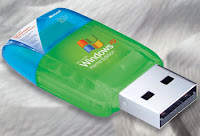 USB flash drive has become a commonly used device that acts as a "travel filing cabinet". In replacing the bulky stacks of CDs, this compact device makes it easier for everyone to have their important files and documents on the go. And since this device has replaced whatever we used to place in our "once floppy disks", perhaps it is the best time to transfer all files into this innovative data storage device. This usually calls for the need to boot USB flash drive in floppy mode.
USB flash drive has become a commonly used device that acts as a "travel filing cabinet". In replacing the bulky stacks of CDs, this compact device makes it easier for everyone to have their important files and documents on the go. And since this device has replaced whatever we used to place in our "once floppy disks", perhaps it is the best time to transfer all files into this innovative data storage device. This usually calls for the need to boot USB flash drive in floppy mode.When we say boot, it basically means manipulating the features and settings of computer hardware and software to serve our purpose. This is also applicable to external hard drives such as USB flash drives. In successfully booting the flash drive in floppy mode, you get to access a:drive and get the images from your floppy disc. In this manner, you can make use of the image to make a bootable CD. The other great thing that you get out of this is the use of "raw write". This is a utility for windows that allows the computer to write the floppy image to the USB flash drive. Even without the hard disk utility, making the USB thumb drive bootable can do just the trick.
Here are some of the things that you need in doing this project:
* A PC that supports booting from USB flash drive. Check the BIOS for details. No problem for newly bought computers for recently manufactured units supports this functionality.
* A flash drive that supports booting applications in general; contains boot/system files and bootsector area.
* References to A: drive lines.
* A formatted floppy disk in WinXP when using XP as bootdisk.
To actually boot a USB flash disk into Floppy mode, it needs to be made bootable first.
Here is how to manually make your USB flash disk bootable:
* Make the USB drive lead the drive sequence. The flash disk will not allow any of the partition to be active or bootable in any other way. To do this, simply plug the drive in, power the computer and go to the BIOS and initiate boot sequence. If this did not work, disable or unplug the other drives in the system.
* Boot your computer to a DOS shell from the bootable floppy disk or CD and make sure that the USB flash drive is already plugged in.
* Run the flash disk.
* Initiate setting of primary partition on the USB drive by click on the "set active partition" option in flash disk. If your USB flash disk does not have a primary partition, then use the flash disk to create one.
* Exit flash disk.
* Reboot the computer this time with a DOS shell from a bootable floppy disk or CD with the USB already plugged in.
* Verify the contents of the primary partition of the USB drive, you can use of the DOS command "dir c:"
* Format and copy the boot file to the primary partition of the USB flash drive, you can use the DOS "format /s c:" command.
Write the master boot record to the USB drive by running "fdisk /mbr", do this without altering the partition table.
* Restart the computer after booting the USB drive. If everything went well, the c:> command prompt will appear.
These tips may or may not be effective, even when done correctly. In any problem regarding your USB flash drive booting problems, you may consult a qualified technician.

0 comments:
Post a Comment